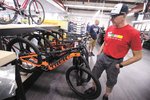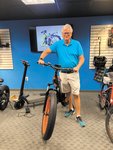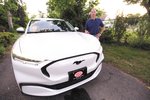By JOHN HOWELLand EMMA BARTLETT
Lloyd Albert, first vice president at AAA New England has been though dramatic gas increases before and what motorists will do to reduce consumption including …
This item is available in full to subscribers.
We have recently launched a new and improved website. To continue reading, you will need to either log into your subscriber account, or purchase a new subscription.
If you are a current print subscriber, you can set up a free website account by clicking here.
Otherwise, click here to view your options for subscribing.
Please log in to continue |
|



By JOHN HOWELL
and EMMA BARTLETT
Lloyd Albert, first vice president at AAA New England has been though dramatic gas increases before and what motorists will do to reduce consumption including putting their cars in neutral and coasting downhill. The term is hypermiling which was in vogue when gas prices last peaked at $4.11 on July 11, 2008. Albert estimates the practice that he recommends against for safety reasons might save 3 to 5 percent in fuel consumption.
“You might save a couple of bucks here and there,” Albert said. He said motorists can save as much, if not more, by ensuring their car is in good working order including properly inflated tires and a clean air filter. (A complete list of AAA recommendations is listed at the end of this article.)
Albert sees the automotive industry going through a long range transition to electric vehicles.
It’s the immediate pinch that is having people dependent on gas and diesel vehicles to change their routines and modes of transportation. As a random survey of Rhode Islanders and those in key positions found, $5 a gallon gasoline has people watching their pennies and thinking of changing their commuting routines.
Many service stations offer lower prices for cash purchases of gasoline with savings ranging up to almost 10 cents a gallon. The Patel brothers who operate the Gulf Express on West Shore Road in Conimicut have found an increase in cash- paying customers. They are also seeing more visits from regular customers who either can’t afford to fill up, or are hopeful the recent dip in prices continues. Overall, they si a decline in consumption that they put at 20 percent.
With reduced use in automobiles one would imagine there would be a corresponding increase in mass transit. That hasn’t happened yet former Warwick Mayor and President and CEO of the Rhode Island Public Transit Authority Scott Avedisian said last week. Asked if the authority has plans to expand its beach services in anticipation of increased demand, Avedisian said that would be addressed when and if that should happen.
Some people are looking to electric bikes even though from a purely financial perspective the return on investment is long term. Gary Stafford, a sales representative at Trek Bicycle Warwick, the largest Trek dealership in the state based on Post Road south of Apponaug, said pedal assist E-bikes start at $3,000 and can range up $8,000 for the mountain bike version designed to handle rocky terrain while keeping the wheels on the ground and the driver on the bike. Stafford has seen an increase in E-bike sales, which he doesn’t attribute solely to the cost of gasoline. He points out with E-bikes couples with differing levels of stamina and ability can take trips together.
“Families can bike together without leaving someone behind,” he said.
He said the bikes, depending on the level of assist, have a range of 150 miles on a full charge.
Over at Aviva Electric Bikes on Carding Lane in Johnston, owner Mike Dressler said a month ago he received calls from individuals looking to purchase E-bikes as a way to save on gas. Since then, the inquiries have dwindled. He believes people are afraid of spending more money since they are already putting funds toward historically high gas prices. While purchasing an E-bike is an investment, Dressler said it costs eight to 10 cents to charge an E-bike for 25 miles.
For those who have decided to commute to work by bike, Dressler said cyclists should wear a helmet and have a six-foot cable lock which he recommends putting around the rear wheel and a pole. There are also baskets that can be attached to the front and rear of the bike to hold bags. Dressler said most of the store’s E-bikes have LED brake lights which are a unique feature.
The E-bikes’ speed range from low to high and go from 10MPH to 20 MPH – the highest speed peaking at 25 MPH. The bikes are fast, have no sound and require half the amount of effort when riding. Additionally, the eight-pound battery will take three to four hours to fully charge and on average lasts two years before needing a replacement battery which Aviva Electric Bikes can restore on site.
Dressler said the most popular E-bike brands his store sells are the Aviva Scout and Vtuvia models, which are good for all seasons and inclement weather. The business also sells the Aviva Folding Bike which has a built in handle and can easily fit in the trunk. Most E-bikes are roughly 52 lbs.
The cost of gasoline isn’t what drove Frank Lenox to buying a Ford Mustang E although he gets satisfaction driving past gas stations.
It was time for him to buy a car. His 2007 Ford Free Style was tried. She had 160,000 miles on her. Lenox looked at used cars, finding they cost nearly as much as new ones. He figured he would spend close to $40,000 for a new car.
An East Greenwich High School teacher, Lenox also took into consideration his commute and how much he would be driving the car. The environment was also on his list of considerations. As Lenox looked at the state and federal tax incentives to buying electric - $2,500 from the state and $7,500 federal – an electric car at $50,000 seemed possible although his wife Ann questioned it.
Lenox looked at what Tasca Ford had to offer. He compared models and sticker prices and once he settled on the Mustang and the features it offered he picked it over a SUV seeing that it has the space he wanted. He made a $500 deposit on the Mustang and was told it would arrive in a month. If he changed his mind, the deposit would be returned but there would be no period to think it over. The car would go to someone else. Buying a Tesla, which he also considered, would have been a four-month wait.
Lenox finds technology has changed driving. He can start his car with his phone and there are features like Bluetooth and backup cameras that weren’t on the 2007. He’s also conscious of the battery, not letting it drop below 20 percent before charging. The range on a full charge is about 250 miles but that can fluctuate based on the type of driving and the temperature. Lenox says an electric is more efficient driving around town, with lots of stops and slow speeds than a gas powered vehicle but less efficient at higher speeds and longer distances. In the winter Lenox expects the range of the car to drop as he will also be drawing upon the battery for heat.
With gas prices bumping $5 a gallon, Lenox estimates he’s saving about $225 a month. And with the tax incentives, he rationalizes the car has really costs $40,000, not the jarring $50,000.
As for performance, Lenox is sold. The Mustang has lived up to expectations. He doesn’t miss the sound of a motor although he can get it should he want it.
“It pumps in sounds and it feels like you’re driving Mustang, which is pretty funny.” Lenox doesn’t use the feature.
Yet there’s a demand for gas driven cars, especially lower used cars says Steve Paiva, the owner of Continental Auto in Seekonk. A Warwick resident, Paiva has owned the dealership for more than 25 years and what he sees now has him fearful the country is headed for a recession.
He said that prior to the pandemic, the practice of many was to buy a new car every three to four years. That provided for a stream of reasonably good second hand cars. With the pandemic and production cutbacks along with chip shortages and supply chain issues, new cars aren’t readily available and selling at sticker prices.
“They’re over priced if you can get them,” he said.
Paiva said what people are looking for “is anything that runs nice for $6,000.” What he sees is, “things shutting down” as with increasing interest rates, credit tightens and purchases including those of new and used cars are beyond the reach of many. His advice for those with money is to treat it like butter, “spread it as far as you can.”
AAA offers the following tips to save on gasoline:
Comments
No comments on this item Please log in to comment by clicking here